Requirements for management systems in holding companies
Despite the fact that the quality management standard is the basis for confirmation of QMS compliance, there are some additional regulatory requirements defined by accreditation bodies and imposed on certification communities. These requirements directly affect the building and management of the QMS.
For 14 years, TMK Group (TMK) has been working with Lloyd's Register Quality Assurance Ltd (LRQA), which is part of the Lloyd's Register Group and assesses compliance with basic standards of quality, environmental protection and industrial safety. The unique audit methodology of LRQA Business Assurance contributes to the development of a quality management system and risk management to improve and protect current and future business performance indicators. A fundamental feature is the approach to auditing, as a tool of assistance (the so-called "value added") in the implementation of strategic goals and objectives. When conducting a QMS conformity assessment, particular importance is given to the effectiveness of process management within the framework of the declared application and extension of the corporate quality management system in the company. In particular, one of the innovations in assessing corporate QMS was the requirement of IAF MD 1: 2018 “Mandatory Document for the Audit and Certification of a Management System Operated by a Multi-Site Organization” [1], a document of the International Accreditation Forum prescribing the requirements for holding audit and certification of the management system of Companies / Organizations having several production sites in different places. In other words, the requirements for evaluating corporate QMS for organizations with a holding structure for managing enterprises.
IAF (The International Accreditation Forum) is an international association of accreditation bodies, associations of certification bodies and other organizations involved in conformity assessment activities in various fields, including management systems, products and personnel.
LRQA (Lloyd's Register Quality Assurance Ltd) - A certification body accredited by UKAS.
UKAS (United Kingdom Accreditation Service) - The national accreditation body of the United Kingdom, is a member of the IAF.
According to the requirements of IAF MD 1: 2018:
“- The organization* must have a single management system.
- The organization must determine its key site. The key site is part of the organization.
- The key site should have organizational powers to determine, establish and maintain a unified management system.
- The unified management system of the organization is subject to centralized review by management.
- The organization’s internal audit program should be extended to all sites.
- The key site is responsible for ensuring the collection and analysis of data from all sites and should be able to demonstrate its authority and ability to initiate organizational changes in accordance with, but not limited to, the requirements for the following items:
• system documentation and system changes;
• management review;
• claims;
• assessment of corrective actions;
• internal audit planning and evaluation of results;
• legislative and regulatory requirements related to the applicable standard (s)...”
* “Organization” - an organization with several sites in which a unified management system is applied and which includes a certain key site (not necessarily the organization’s headquarters), where certain processes / actions are planned and controlled, as well as a number of sites (permanent, temporary or virtual (using an online environment) on which such processes / actions are performed in whole or in part (IAF MD 1: 2018, 2. DEFINITIONS)
TMK is a dynamically developing company. In order to maintain and strengthen its position, the strategy guides the business towards achieving one of the strategic objectives – “To be a recognized supplier in the world pipe market and a leader in the domestic pipe market”. An effective corporate quality management system confirmed by independent bodies and recognized by customers helps to achieve this objective.
Therefore, in the course of the upcoming recertification, TMK Group needs to confirm that the corporate management system not only complies with ISO 9001 - 2015 [2], but also demonstrates centralized management of the QMS and the ability to achieve the expected results in the divisions and at the enterprises included in the holding’s contour, according to IAF MD 1: 2018.
Specifics of building QMS in holding companies, in particular in those with the divisional management principle
How to ensure the requirements of the certification body and what are the main differences in management of QMS at local enterprises and in holding companies, including international holding companies built on a divisional basis?
The process model of the QMS of a local enterprise with legal independence is usually based on a chain of business processes, the sequential activity of which makes up a single administrative management system. The synchronization of administrative management and the quality management system, as a rule, ensures the effectiveness of management; there is no conflict of interest, because the organizational structure of the enterprise forms the basis of the QMS process model.
In contrast to the QMS of a local enterprise, when developing a process model of a corporate QMS of a holding company the IAF requirements must be taken into account.
In particular, the business structure of TMK Group is an association of a number of enterprises based on property rights headed by the management company and located both in the Russian Federation and abroad. The enterprises produce tubular products, engage in procurement and sales activities and provide follow-up services to support the use of products of the holding company at the customer’s site.
The corporate quality management system (CQMS) of TMK Group at the initial stage of its development was built on the basis of a functional management system. The CQMS was built on the collective principle of including local QMS of enterprises with account of the degree of their development.
The decision to implement the CQMS in TMK Group was made by the management company and it took into account the individual characteristics of the enterprises. Therefore, the process model (Figure 1) at the first stage was created with account of the local processes that are typical of most of the Group’s enterprises (without standardization for creation of a process model at local levels), and their relationship with the processes that are implemented by subdivisions at the level of the management company.
A minimum essential set of corporate requirements was formed and it, in its turn, determined the requirements for managing processes to be implemented at the enterprises. This approach turned out to be absolutely justified at the initial stage of building the CQMS and had its advantages such as minimizing the risks connected with the integrity of the CQMS, since its integrity was made up by the fundamental corporate requirements and additional local requirements established by the enterprise individually. Each of the TMK Group enterprises had an opportunity to maintain and develop its local QMS within the corporate system, taking into account its specifics and integration with other applicable management systems; and at the same time, it could provide communications on interconnected corporate processes with the management company.
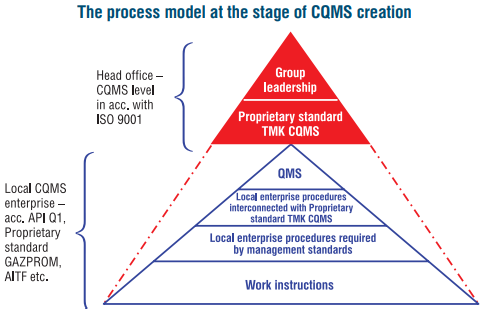
Figure 1 The process model at the stage of CQMS creation
At the later stages of improving the Company's management system, organizational changes in TMK Group and implementing management on a divisional basis, the CQMS process model should have changed taking into account new management levels, creating new processes, interpreting the applied processes according to the total quality management principle implemented through all management levels of TMK Group.
To achieve this objective, the over-arching processes at the corporate level should include uniform requirements for all TMK Group Divisions and local enterprises. The unity and continuity of requirements was partially achieved through unified criteria, objectives and processes established for all TMK Group enterprises. But under the influence of local territorial requirements and the external context, in particular, the legislative specifics of the countries where TMK Group enterprises operate, the task turned out difficult to achieve at the enterprises of foreign divisions. For this reason, a part of corporate processes was fully applicable only to the divisional processes within the area of responsibility of the Russian Division of the Company.
This factor had an impact on the integrity of the CQMS, the recording of observations during the audit of Lloyd's Register and required a study of the experience of building process models of CQMS management in external large holding companies, in order to assess the possibility of applying this experience in TMK Group and make decisions acceptable to TMK Group with a view to improving the CQMS.
The results of the review showed that the key factor in making a decision on the design of the process model was the presence of CQMS processes of the highest level in the management company, built on the basis of the holding’s administrative management system (Figure 2).
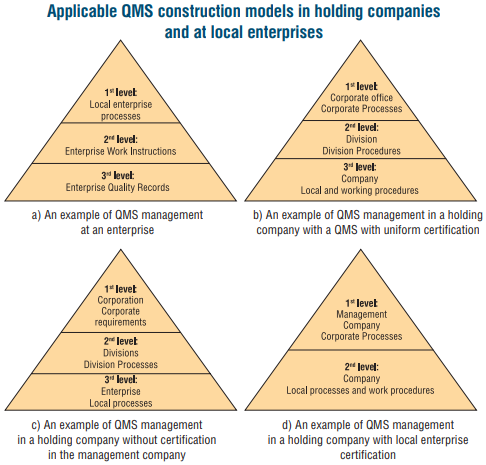
Figure 2 Applicable QMS construction models in holding companies and at local enterprises
Figure 2a shows the classical management model of the QMS of a local enterprise; formation of the process model and distribution of responsibility and authority in the QMS is carried out in accordance with the administrative management system.
An example of building a QMS in a foreign holding company with divisional management (Figure 2b) is based on identification of corporate processes at the level of the management company that apply to divisions, enterprises of the holding for the formation of divisional procedures and enterprises equally. This model simplifies communication with the divisions, enterprises and subdivisions without any discrepancy of requirements between the hierarchical levels, provides centralized management and control of corporate requirements in the holding company.
An example of a corporate process model with corporate governance, but with QMS certification only at the level of the enterprises of the holding company is presented in Figure 2c. The management company determines the corporate process model and corporate rules for development and functioning of the QMS at the divisional level and at the level of enterprises with local certification; it manages and controls implementation of requirements at the level of the divisions with selective verification to the level of the enterprises without maintaining QMS certification in the management company.
Another way to build a corporate QMS with management levels, when the management company determines corporate requirements, but at the same time maintains a local QMS at its level along with local certifications of QMS of the enterprises, is presented in Figure 2d.
Guided by the main objective of development of the CQMS in TMK Group, namely, to create a management model that will make it possible to maintain its integrity, ensure that processes at all levels are strictly interconnected, control and regulate the impact and performance of all components of the system – the division, enterprise, process, activity and document on the system as a whole, measures have been developed and implemented to change the process model and design of the CQMS of TMK Group by way of:
1) Changing the approaches to process model management. Using the principle of uniformity with the divisional organizational management system of TMK Group.
2) Definition of common approaches to management of CQMS processes.
3) Ranking the hierarchy of processes by management level (corporate, divisional and local).
4) Bringing corporate CQMS processes to the target business scheme.
5) Unification of CQMS processes and CQMS documentation.
Process model and process landscape design selection
At the stage of determining a new design of the process model, the following was considered: the structure of the Group with the divisions and the enterprises that they are comprised of; identification of the governing body depending on the availability of management functions at each level; and legal relationships between local enterprises and the management company. A general scheme of the CQMS is shown in Figure 3.
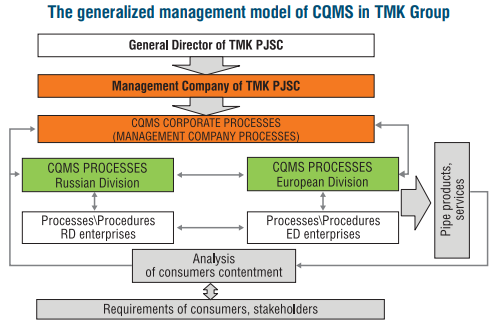
Figure 3 The generalized management model of CQMS in TMK Group
Thus, a three-level process model was formed and the purpose of processes for each level were defined (Figure 4):
• The management company of TMK Group implements the functions of corporate process management and centrally controls the performance of these functions. For divisions outside the Russian jurisdiction, general requirements in the area of activity are established, on the basis of which divisional processes are developed. The purpose of corporate processes is strategic planning and setting of key indicators as well as divisional management within CQMS.
• The divisional management level in the CQMS carries out planning and management of divisional processes, develops targets, implements corporate requirements with account of the regional specifics of location of the production sites and the national legislation.
• The production level carries out operational management of the processes of the local enterprise taking into account the divisional requirements, setting and achievement of targets for the enterprise processes.
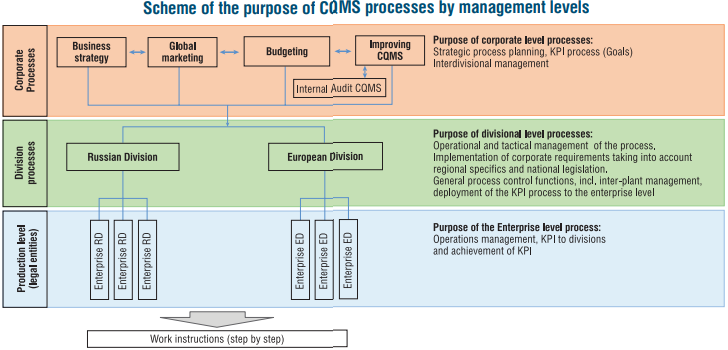
Figure 4 Scheme of the purpose of CQMS processes by management levels
To form a landscape of processes for each level of management, the list of CQMS processes is determined by the decision of top management based on:
1) the strategy and strategic priorities of TMK Group / division / enterprise;
2) the area of activity of TMK Group / division / enterprise;
3) the area of distribution of the CQMS;
4) the context of TMK Group / division / enterprise;
5) the financial model of TMK Group.
Processes of the corporate level include processes based on activities that are carried out in relation to all divisions of the Group. These are management processes that determine strategic orientation of the company, form the structural framework and relate to the area of responsibility of the management. Management: PAO TMK (management on the basis of the target business structure “organization of provision of other services”). Owner of the corporate process: TOP manager of the relevant business area in the management company.
Processes of the divisional level include divisional processes in the Group, which are formed on the basis of corporate processes and processes that are carried out in the division. At the same time, the composition of processes is formed based on the field of activity, territorial legal norms, and local legislation of the division. Management: management company (head office) of the division (MC of the division). Process Owner: TOP manager of the relevant business area in the division.
Processes of the production level of the enterprise include local processes of the enterprise, defined by the production infrastructure and specialization that in their turn are formed on the basis of divisional processes. Process Owner: Manager of the relevant business area at the enterprise.
In this landscape, corporate, divisional and local processes are interconnected and, on the one hand, implement the requirements of customers and create additional value for customers and, on the other hand, they make it possible to set and implement TMK development strategy, support, monitor and improve CQMS processes within the Group (Figure 5).
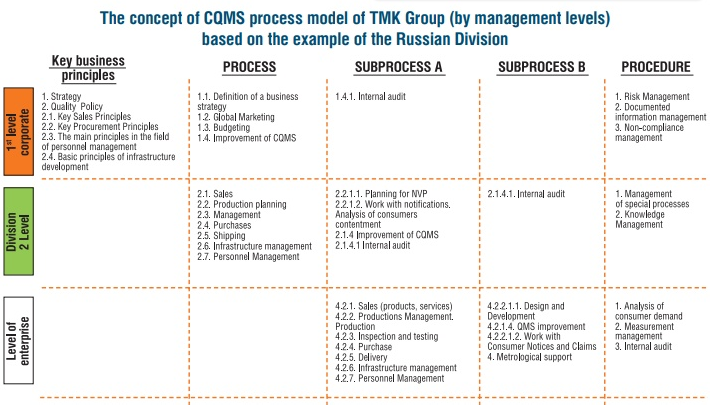
Figure 5 The concept of CQMS process model of TMK Group (by management levels) based on the example of the Russian Division
The unifying factor in this model is the processes and provisions of the corporate level, within which the key indicators of the CQMS are established (quality policy, quality objectives, process targets, etc.). Divisional processes, which are over-arching processes, are set up as a tool to increase customer satisfaction, both internal and external, ensuring repeatability and stability of positive results. Aggregation, monitoring and analysis of data on key indicators of the CQMS are carried out at the divisional level.
Implementation of corporate requirements is monitored at the level of TMK Group management company through the CQMS internal audit system as one of the ways of monitoring the efficiency of the system. Review of performance of the CQMS at the level of top management of the management company and divisions is one of the ways of determining the status of the system's development, making timely decisions and taking measures to confirm the suitability, adequacy and ability of the CQMS to meet the requirements of quality management standards; it is a platform for planning actions in order to achieve intended results and increase customer satisfaction both at the level of the group as a whole and across the divisions.
As part of development and improvement of the CQMS, TMK Group has developed and implemented a flexible and effective business management tool that can be adapted to changes in the context and business environment of the company.
The proposed design of the process model of the CQMS for the Group with a divisional management system makes it possible to cooperate and jointly manage the corporate quality management system in the divisions and at the enterprises that are part of the Group even though they are located in different countries with different legal jurisdictions, and at the same time maintain a common corporate culture, long-term partnership relations and unified certification; it makes possible to position TMK Group in the market as a single company – a supplier, focused on the values of internal and external customers.
However, in order to see opportunities to fulfill customer expectations, to improve performance and efficiency of the quality management system, and to eliminate or prevent undesirable consequences to take no further action is not an option. The company needs to keep pace with the times and for this reason the next objective is to reach a new level in CQMS development, which will include optimization, automation and digitalization of the process model management, planning and implementation of life cycle processes, management of CQMS key performance indicators. TMK Group is already implementing its development plans in this area, but we will cover that in the following publications.
References:
-
IAF MD 1:2018 “IAF Mandatory Document for the Audit and Certification of a Management System Operated by a Multi-Site Organization”, Issue 2 © International Accreditation Forum, Inc. 2018
-
ISO 9001 International standard. Quality Management Systems. Fifth Edition. 2015
Author:
Lyudmila Beltseva
Head of Quality Management System Service, PAO TMK



